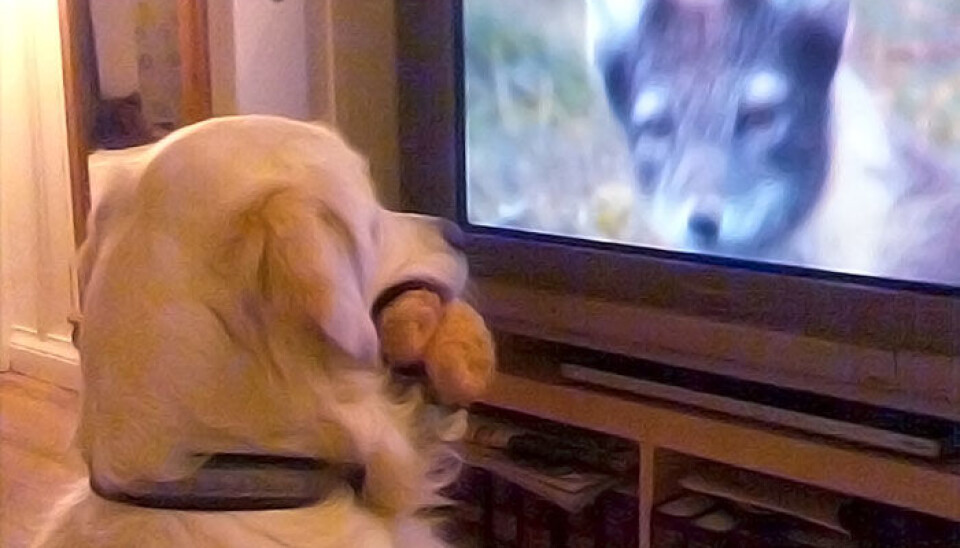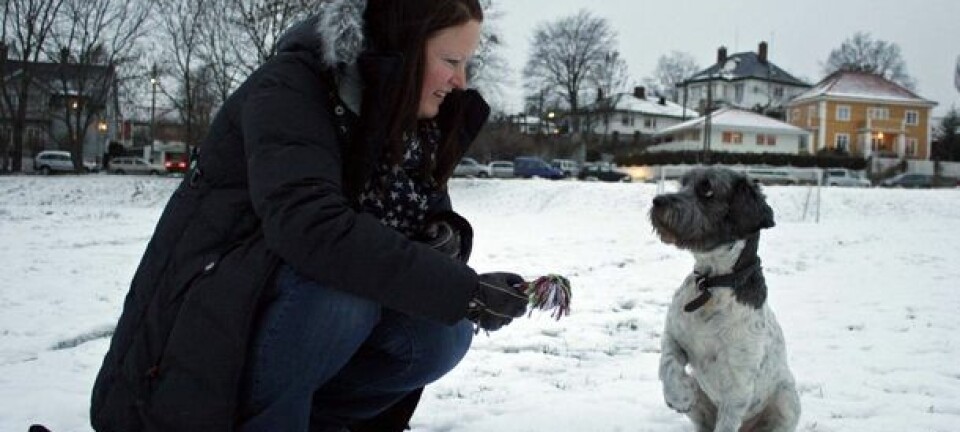
Do dogs see what’s happening on TV?
Dogs often watch TV with their owners. What do our furry friends see on the screen?
Denne artikkelen er over ti år gammel og kan inneholde utdatert informasjon.
People often say that dogs can't actually see what is going on when they watch television --but is that true?
And what about modern TVs − does the higher resolution of the new screens better enable Fido to see what is going on?
“They probably see the new TVs just as well as they see the world in general,” answers Ernst Otto Ropstad, an associate professor at the Norwegian School of Veterinary Science. Ropstad specialises in animal vision.
“Now that modern TVs generate more frames per second, dogs can perceive the pictures as film, just like we do,” he says.

Fusing a rapid set of images into what our eyes register as a moving picture is called flicker fusion frequency. New TVs are much smoother than old TVs, which could only produce up to 50 new frames a second.
Animals vary with regard to how many frames they need to see per second before it fools their eyes and brains into viewing it as a moving picture, rather than a flickering image on a screen.
Canine channels
We humans need about 16 to 20 images a second to perceive what we see as continuous film, whereas dogs need about 70 images per second.
So a few years ago, Fido was probably confounded by his master's behaviour of sitting for hours staring at a flashing succession of images. With modern resolution and quicker imaging, dogs have become potential television viewers.
This has not gone unrecognised in the USA, for example, where hopeful TV producers have started special TV channels for dogs.
If you have other pets, however, you need to think twice before placing them in front of the TV.
Birds need at least 100 frames per second to see TV images as a moving picture. Having a bird in the same room as a TV with a lower frame rate than that will be very stressful for the creature.
“It’s cruelty to animals,” says Ropstad. “It’s like putting you in a room with strobe lights, like in a discothèque.”
Nevertheless, while dogs can now see what’s happening on TV, they still don’t see the same as we do.
More cones for better colour
“Dogs see colours, but not the same colours we see,” says Ropstad.
Colour vision comes from cone cells, which are receptors on the retina. To see colours you need at least two different kinds of cones.
Dogs have two, and we humans have three.
“This means, for instance, that what we perceive as red will be seen by dogs as yellowish or white,” says the researcher.
These cones also affect our perception of details, so dogs have poorer detail vision than we do.
Spotting birds
Ropstad says that dogs see TV as well as we do but it’s relative to their general vision:
“They see details on the new TVs, sure, but not completely clearly.”
Dogs can see a bird flying across the TV screen in about as much detail as they see it in nature.
So it’s no surprise that some dogs jump at the TV when a wolf or horse suddenly turns up right in the living room.
But it should be noted that not all dogs necessarily see equally well.
Limited research on dog TV
“No research has been made regarding differences in breeds as regards how many images per second they need to perceive TV as film,” Ropstad says.
He thinks there are individual differences in dogs, even though science doesn’t have an answer yet to why this is so.
He has conducted research on five bird dogs and says some of them are interested in TV, while others couldn’t care less.
One of his dogs is very watchful if it sees a bird or another dog crop up on the screen.
A dog that loves chasing tennis balls might be intrigued by a broadcast from Wimbledon, he thinks.
If you have a dog that eagerly watches animals on TV, but understands they aren’t really there in the room, then you might have a real canny canine.
Hunting instincts take over
Bjarne Braastad is a professor at the Department of Animal and Aquaculture Sciences at the Norwegian University of Life Sciences.
The professor owns cats and says they like to watch TV now and then, especially if there are birds or mice in view.
He thinks you have a wise dog if it comprehends that the animal on TV isn’t real.
“Some might jump at the TV, attacking it, but most soon learn there’s no animal there.”
“You can say that if the dog doesn’t learn from experience, that it cannot capture what’s on the screen, then its behaviour is dominated by instinct.”
When an animal is hunting, what catches its eye is motion against a steady background, which is why TV images can trigger its hunting instinct.
“If it’s a dominant instinct, the dog's behaviour won’t be impacted much by its own learning,” says the professor.
Fortunately, dog owners who have pets that bark at the TV can train them to curb this annoying instinctive behaviour.
“You can break the habit,” says Braastad, and advises using commands the dog already responds to, such as ‘no’ and ‘sit’.”
Translated by: Glenn Ostling

































